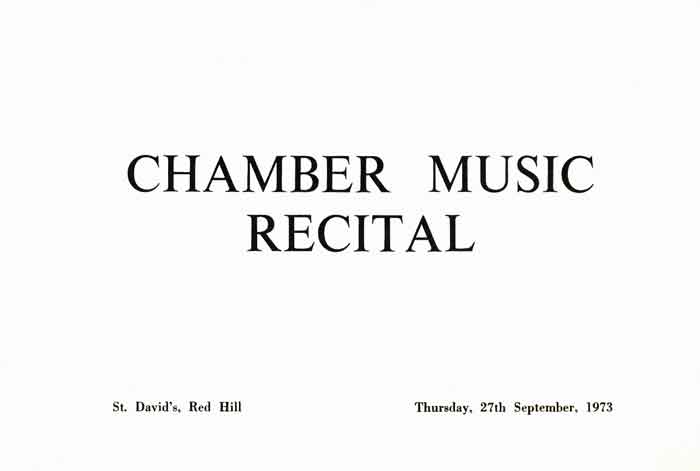
Transcription
CHAMBER MUSIC RECITAL
St. David's, Red Hill
Thursday, 27th September, 1973

SCUNA history » Groups with a link to SCUNA » The Chamber Choir
On this page:
Mentions elsewhere on this site:

St. David's, Red Hill
Thursday, 27th September, 1973
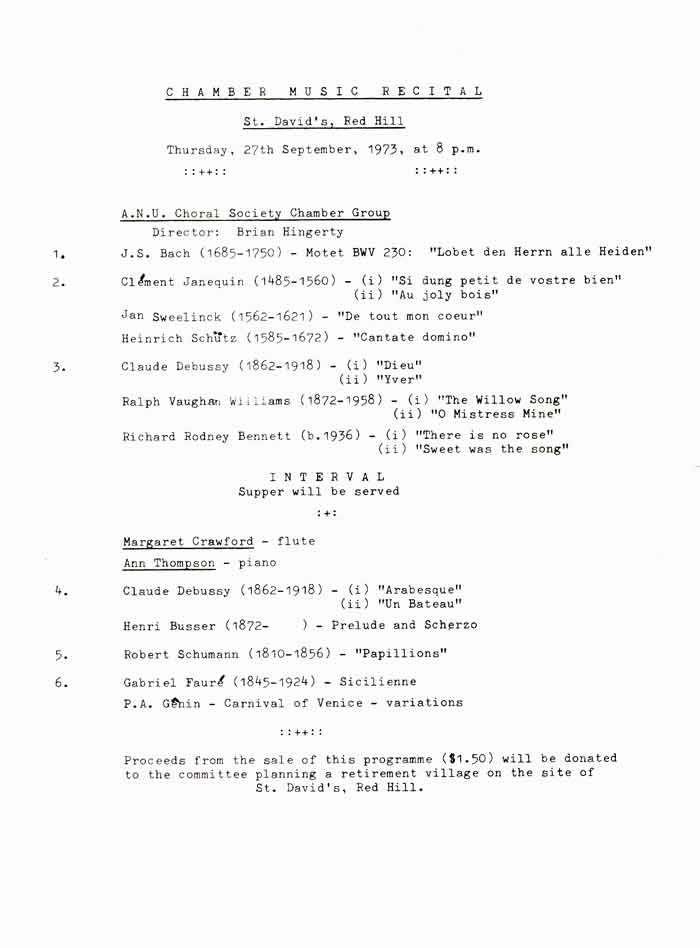
St. David's, Red Hill
Thursday, 27th September, 1973 at 8 p.m.
::++:: ::++::
Director: Brian Hingerty
| 1. | J.S. Bach (1685-1750) | - | Motet BWV 230: "Lobet den Herrn alle Heiden" |
| 2. | Clément Janequin (1485-1560) | - |
|
| Jan Sweelinck (1562-1621) | - | "De tout mon coeur" | |
| Heinrich Schütz (1585-1672) | - | "Cantate domino" | |
| 3. | Claude Debussy (1862-1918) | - |
|
| Ralph Vaughan Williams (l872-1958) | - |
|
|
| Richard Rodney Bennett (b.1936) | - |
|
|
INTERVAL |
|||
Supper will be served |
|||
:+: |
|||
Margaret Crawford - flute
|
|||
| 4. | Claude Debussy (l862-19l8) | - |
|
| Henri Busser (1872- ) | - | Prelude and Scherzo | |
| 5. | Robert Schumann (1810-1856) | - | "Papillons" |
| 6. | Gabriel Fauré (1845-1924) | - | Sicilienne |
| P.A. Gênin | - | Carnival of Venice - variations | |
::++::
Proceeds from the sale of this programme ($1.50) will be donated to the committee planning a retirement village on the site of St. David's, Red Hill.
Brochure - four of five pages |
Transcription |
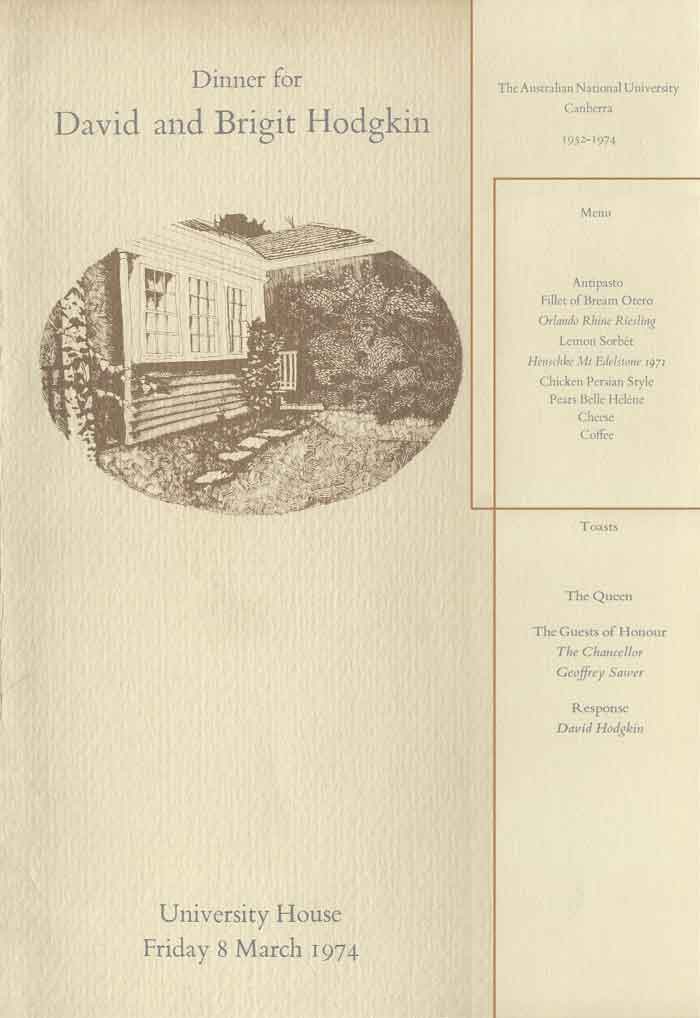 |
Cover (left hand side) |
|---|---|
Dinner for David and Brigit Hodgkin |
|
| [Drawing of Balmain Crescent house] | |
| University House Friday 8 March 1974 |
|
| Page 2 (right-hand top) | |
| The Australian National University Canberra |
|
| 1952-1974 | |
| Page 3 (right-hand middle) | |
Menu |
|
| Antipasto Fillet of Bream Otero Orlando Rhine Riesling Lemon Sorbet Henschke Mt Edelstone 1971 Chicken Persian Style Pears Belle Helena Cheese Coffee |
|
| Page 4 (right-hand bottom) | |
Toasts |
|
| The Queen | |
| The Guests of Honour The Chancellor Geoffrey Sawer |
|
Response |
|
| David Hodgkin |
Brochure - final page |
Transcription |
 |
ANU Choral Society Chamber Group directed by Brian Hingerty |
| During entry | |
| 'Psaume 126' - Marc Antoine Charpentier' (17th century) |
|
| During dinner | |
| Three Madrigals - Claudio Monteverdi (17th century) |
|
| 'Lasciate mi morire' 'Ecco mormorar 1'onde' 'Si ch'io vorrei morire' |
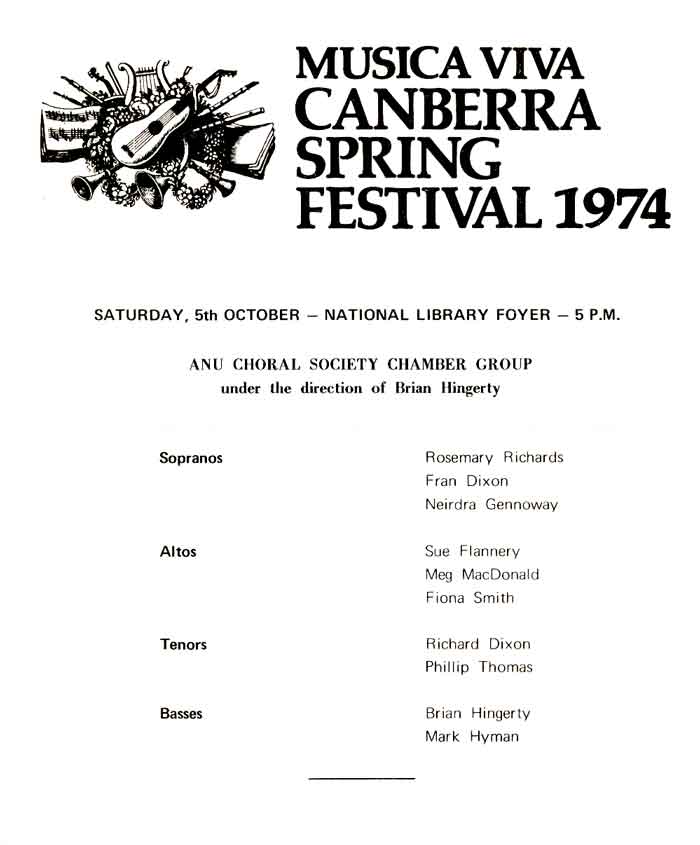
SATURDAY, 5th OCTOBER - NATIONAL LIBRARY FOYER - 5 P.M.
ANU CHORAL SOCIETY CHAMBER GROUP
under the direction of Brian Hingerty
| Sopranos | Rosemary Richards Fran Dixon Neirdra Gennoway |
| Altos | Sue Flannery Meg MacDonald Fiona Smith |
| Tenors | Richard Dixon Phillip Thomas |
| Basses | Brian Hingerty Mark Hyman |

1. "FOUR MADRIGALS" - Bohuslav Martinu (1890-1959)
2. "VERSES I, II, III" - Richard Rodney Bennett (b. 1936)
3. "DIE WEIHNACHTSGESCHICHTE" - Hugo Distler (1908-1942)
for four-part chorus, a capella, and four solo voices.
4. "THREE AUSTRALIAN SONGS - from the ARCHIVES of the NATIONAL LIBRARY"
Handwritten: The Internationale, Song of Australia, Road to Gundagai
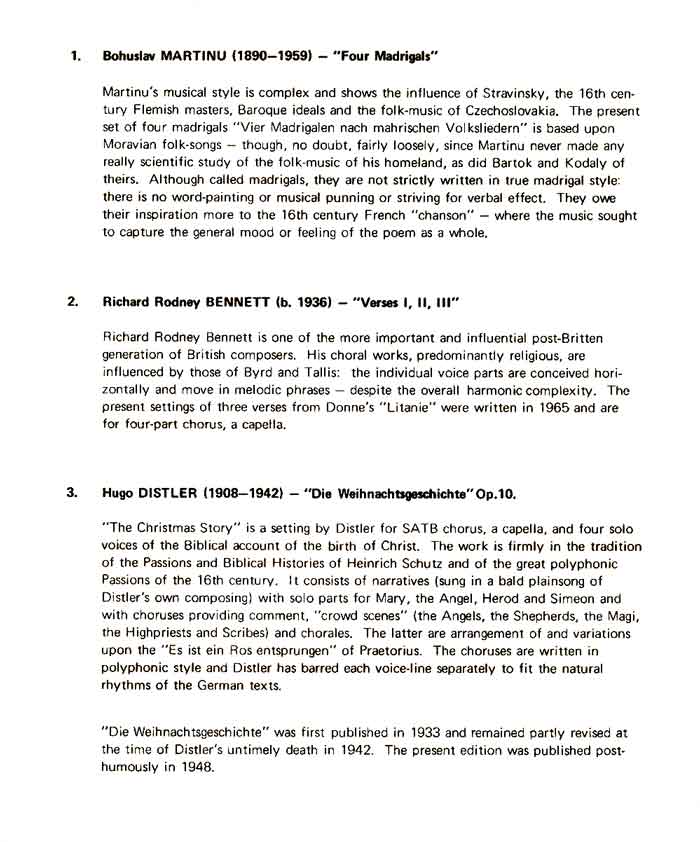
1. Bohuslav MARTINU (1890-1959) - "Four Madrigals"
Martinu's musical style is complex and shows the influence of Stravinsky, the 16th century Flemish masters, Baroque ideals and the folk-music of Czechoslovakia. The present set of four madrigals "Vier Madrigalen nach mahrischen Volksliedern" is based upon Moravian folk-songs - though, no doubt, fairly loosely, since Martinu never made any really scientific study of the folk-music of his homeland, as did Bartok and Kodaly of theirs. Although called madrigals, they are not strictly written in true madrigal style: there is no word-painting or musical punning or striving for verbal effect. They owe their inspiration more to the 16th century French "chanson" - where the music sought to capture the general mood or feeling of the poem as a whole.
2. Richard Rodney BENNETT (b. 1936) - "Verses I, II, III"
Richard Rodney Bennett is one of the more important and influential post-Britten generation of British composers. His choral works, predominantly religious, are influenced by those of Byrd and Tallis: the individual voice parts are conceived horizontally and move in melodic phrases - despite the overall harmonic complexity. The present settings of three verses from Donne's "Litanie" were written in 1965 and are for four-part chorus, a capella.
3. Hugo DISTLER (1908-1942) - "Die Weihnachtsgeichichte" Op.10.
"The Christmas Story" is a setting by Distler for SATB chorus, a capella, and four solo voices of the Biblical account of the birth of Christ. The work is firmly in the tradition of the Passions and Biblical Histories of Heinrich Schutz and of the great polyphonic Passions of the 16th century. It consists of narratives (sung in a bald plainsong of Distler's own composing) with solo parts for Mary, the Angel, Herod and Simeon and with choruses providing comment, "crowd scenes" (the Angels, the Shepherds, the Magi, the Highpriests and Scribes) and chorales. The latter are arrangements of and variations upon the "Es ist ein Ros entsprungen" of Praetorius. The choruses are written in polyphonic style and Distler has barred each voice-line separately to fit the natural rhythms of the German texts.
"Die Weihnachtsgeschichte" was first published in 1933 and remained partly revised at the time of Distler's untimely death in 1942. The present edition was published posthumously in 1948. [Continues below]
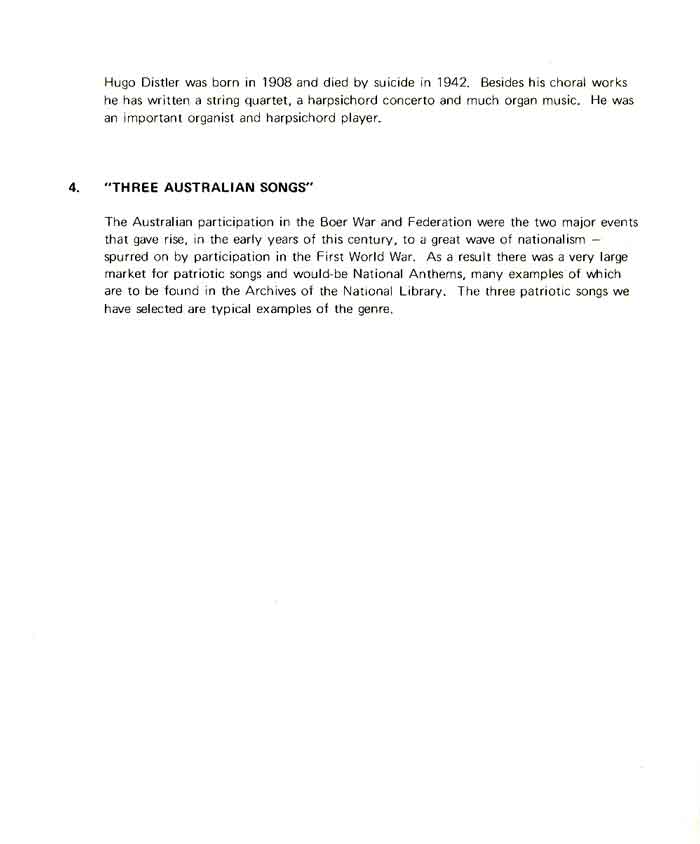
Hugo Distler was born in 1908 and died by suicide in 1942. Besides his choral works he has written a string quartet, a harpsichord concerto and much organ music. He was an important organist and harpsichord player.
4. "THREE AUSTRALIAN SONGS"
The Australian participation in the Boer War and Federation were the two major events that gave rise, in the early years of this century, to a great wave of nationalism - spurred on by participation in the First World War. As a result there was a very large market for patriotic songs and would-be National Anthems, many examples of which are to be found in the Archives of the National Library. The three patriotic songs we have selected are typical examples of the genre.
"Saturday, 5th October: 5p.m. SCUNA Small Group is singing freely in the Foyer of the National Library as part of Musica Viva's Spring Festival. Do come and cheer them on, but please don't laugh during the Australian songs."
- Kathy Warth, Oyez of 3 October 1974